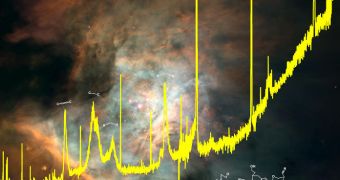A group of investigators from the University of Hong Kong announce the discovery of organic molecules in interstellar dust, confirming predictions made some time ago that stars are able to produce organic compounds naturally.
Interstellar dust, as the name suggests, can be found throughout the Universe, but it is especially concentrated inside galaxies. The team says that the conclusions were derived from studies of stars at various stages in their development.
Depending on the evolutionary phase they're in, stars generally produce different materials and chemicals as a result of conducting nuclear fusion. Regardless of that, experts say, organic compounds are apparently produced and discarded at all times.
Driven by the force of stellar winds, cosmic dust laden with such molecules are then dispersed throughout the interstellar medium, filling the space between star systems. What is even more amazing is that the chemicals themselves are very complex.
According to UHK expert and lead study author Sun Kwok, some of these compounds may have a structure as complex as those of coal and petroleum. Thus far, scientists thought that such a degree of complexity could only arise from living organisms,
Furthermore, it could be that stars produce these chemicals at a very fast pace. “What impressed me most is that complex organics are easily formed by stars, they are everywhere in our own galaxy and in other galaxies,” Kwok explains.
“Nature is much more clever than we had imagined,” the astronomer says, quoted by Space. He and his team published the full details of their work in the October 26 issue of the top scientific journal Nature.
“In the astronomy community, it has been commonly assumed that the UIE [unidentified infrared emissions] features are emitted by [polycyclic aromatic hydrocarbon – PAH] molecules, which are simple, purely aromatic, molecules made of carbon and hydrogen,” Kwok adds.
“Our paper suggests that the PAH hypothesis is not correct,” the investigator adds. He conducted the investigation together with UHK colleague Yong Zhang. The team says that UIE were first discovered some 30 years ago.
The study was conducted using data from the European Space Agency's (ESA) Infrared Space Observatory and the NASA Spitzer Space Telescope, which surveys the sky in infrared wavelengths.
“Since the dynamical/evolution ages are of the order of thousands of years, the appearance of the spectral features suggests that the organic compounds are made on time scales shorter than thousands of years,” Kwok concludes.

 14 DAY TRIAL //
14 DAY TRIAL //